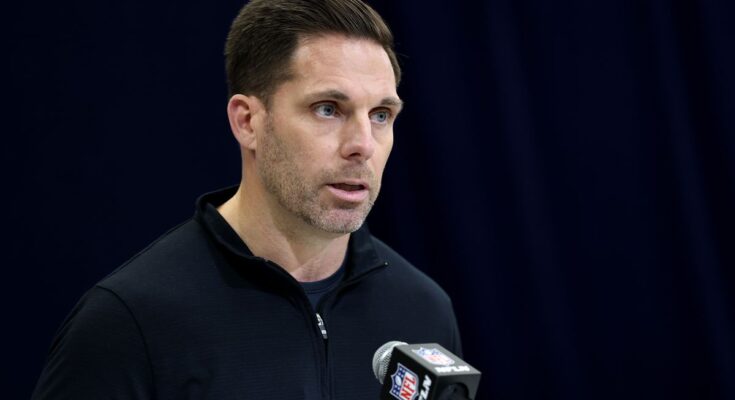Bryce Young’s 2023 Nightmare: Despite Floundering, He Relied on Adam Thielen a Shocking 137 Times, Catching 103 Passes in Panthers’ Historic Collapse
The 2023 NFL season for the Carolina Panthers was, by any measure, a catastrophic failure. Expectations were cautiously optimistic heading into the year, with the organization hoping to take a step forward under new leadership and the potential of young quarterback Bryce Young. Instead, what unfolded was a year defined by broken plays, misfires, and a glaring lack of offensive cohesion that ultimately landed the Panthers at the bottom of the league standings.
At the heart of the Panthers’ offensive struggles was Bryce Young — a highly touted rookie who, despite flashes of brilliance, ultimately floundered behind a shaky offensive line and a lack of supporting weapons. But amid the chaos of a season spiraling out of control, one narrative stood out: Young’s overwhelming reliance on veteran receiver Adam Thielen. A staggering 137 targets and 103 receptions later, Thielen became the focal point of a beleaguered offense that desperately clung to his consistency in an otherwise unstable attack.
To understand the significance of this statistic, it’s important to place it in context. For a quarterback to throw the ball to one receiver 137 times in a single season is noteworthy on its own — but for that quarterback to be struggling and the team to be performing so poorly, the figure becomes emblematic of larger issues within the Panthers’ game plan and offensive execution.
Bryce Young’s rookie year was supposed to be about growth and adaptation. Selected to be the franchise’s future, he entered the league with high expectations but also faced the harsh realities of transitioning to the NFL. In many ways, his struggles were predictable: erratic throws, missed reads, and the kind of rookie mistakes that lead to turnovers and stalled drives. However, what made Young’s 2023 season stand out was the glaring dependence on Adam Thielen — a seasoned receiver who, despite being well into his 30s, managed to shoulder an extraordinary burden.
Thielen’s 103 receptions are impressive by any standard. It’s a testament to his route-running, hands, and football IQ that he could maintain such production on a team that was otherwise failing on nearly every front. Yet this statistic also reveals a deeper malaise in the Panthers’ offense. When one receiver commands such a disproportionate share of targets, it often signals a lack of offensive diversity, predictability, and an inability to develop other weapons.
The Panthers’ offensive line woes can’t be overstated. Young was under constant pressure, forcing him into hurried decisions and limiting his ability to effectively distribute the ball across the field. With receivers struggling to create separation and inconsistent running backs unable to take the pressure off the passing game, the quarterback’s safest option repeatedly became Thielen. His experience and savvy allowed him to find openings and gain yards after the catch, making him the only reliable outlet in a sea of uncertainty.
But even this reliance on Thielen wasn’t enough to spark the Panthers to success. The lack of a balanced offensive attack made the team’s play-calling predictable and easier to defend. Opposing defenses keyed in on Thielen, often double-covering him or forcing Young to beat them with lesser targets. This predictability contributed to the team’s offensive inefficiency and inability to sustain drives, a fatal flaw that led to an anemic scoring output.
It’s also important to note that while Thielen’s numbers shine on paper, they don’t tell the full story of the Panthers’ offensive struggles. The team finished the season near the bottom of the league in points per game and total yards. Bryce Young’s completion percentage hovered in the low 60s, and his touchdown-to-interception ratio was underwhelming, underscoring the challenges he faced in adapting to the speed and complexity of NFL defenses.
Behind these stats lies a larger question about the Panthers’ roster construction and coaching. The offensive scheme appeared to funnel too many plays toward Thielen without developing complementary options or adjusting to Young’s strengths and weaknesses. It suggested a lack of offensive creativity and adaptability, which compounded the team’s woes as opponents exploited these predictable tendencies.
Beyond the X’s and O’s, the human element was equally significant. Bryce Young’s rookie season was a crash course in NFL realities — media scrutiny, fan disappointment, and internal pressure. Despite these challenges, he showed resilience and a willingness to learn. Adam Thielen’s veteran leadership was a stabilizing force, providing a reliable target and mentorship amid the turmoil.
Looking ahead, the Panthers face critical decisions. The 2023 season underscored the urgent need for a revamped offensive line, more dynamic receiving options, and an offensive scheme tailored to Bryce Young’s strengths. Whether through the draft, trades, or free agency, the front office must address these glaring holes if they hope to turn this franchise around.
Furthermore, Bryce Young’s development remains paramount. While his rookie year was far from perfect, the experience gained in adversity can serve as a foundation for growth. Learning to read defenses better, improving accuracy under pressure, and building chemistry with a broader array of teammates will be essential for his progression.
Adam Thielen’s role going forward is less certain. At this stage of his career, maintaining such a high volume of targets is unlikely sustainable, especially if the Panthers want to diversify their offensive attack. Nonetheless, his 2023 campaign was a bright spot in a bleak season, and his professionalism and performance should not be overlooked.
In conclusion, the Panthers’ 2023 season was a harsh lesson in the challenges of rebuilding and the difficulties rookies face when thrust into difficult situations. Bryce Young’s heavy reliance on Adam Thielen — 137 targets leading to 103 receptions — tells a story of a struggling quarterback leaning on a dependable veteran amid a collapsing offense. It’s a narrative of imbalance, unmet expectations, and the need for systemic change.
The Panthers now stand at a crossroads, with a foundation that includes a promising but raw quarterback and a reliable veteran receiver, but with many holes to fill. The lessons of 2023 should serve as a roadmap: build a stronger offensive line, add playmakers around Young, and craft a scheme that can maximize their talent. Only then can Carolina hope to escape the shadows of this disastrous season and build toward a more competitive future.


